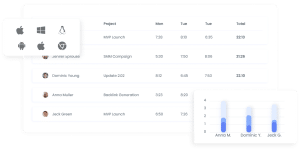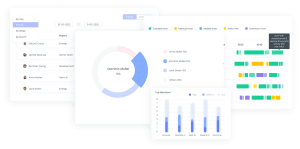Agile is one of the most known project management methodologies today, especially in the IT industry. Many software teams are already using this method and reaping its benefits.
You probably already know a thing or two about Agile but let’s reiterate what it is one more time just in case.
What Is Agile?
Agile methodology approaches project management in a different way. While traditional methods focus on sticking to a plan, Agile focuses on managing a project step by step and welcomes changes along the way.
Agile is also about flexibility. Team members are ready for change and can adapt to changes and additions faster.
Now let’s understand how time tracking benefits Agile in different aspects.
The Purpose of Time Tracking in Agile

The main purpose of time tracking is to help users identify their time-tracking habits, know what exactly every minute is spent on, and improve time management skills as a result.
In the same way in Agile methodology, time tracking helps teams organize their time better and spend it rationally.
I’m sure all teams value their time equally, but not all of them track its usage.
No matter how mindful you are about your time when planning and managing a project, if you are not tracking it, you are somehow not valuing it enough.
As Agile project management requires a lot of planning and frequent meetings, tracking time should be one of the priorities of this method.
Why and How Time Tracking Is Important in Agile
First and foremost, time tracking is important in the beginning, when transitioning from traditional management to Agile. As the adaptation phase may be a bit hard, it is important to track time and monitor the work of employees to make sure the project flow doesn’t suffer.
Of course, you should be forgiving to your employees in the adaptation stage, as they will need time to get used to the new way of working. However, you should also make sure the workflow is as consistent as possible. This is where time tracking can help you and your team.
Time Tracking in Each Stage of Agile

Let’s take a look at the 6 steps of Agile and how time tracking can benefit each of them.
1. How much time the planning takes
Tracking the time spent on planning helps have an exact idea on how long it takes, whether the amount of time spent on it is optimal and whether it needs improvement. Maybe the results show that the amount of the same planning can be done in a much shorter time.
2. How much time each stage will take
As roadmap creation is another planning stage, time tracking is equally important here. At this stage, software teams create an outline for their next actions. Here time tracking helps not only optimize the time spent during this stage but also predict the time for future actions.
3. Release planning
At this stage, time tracking may not be so important, as release planning is less about process and more about goal setting, unless it is part of roadmap creation.
4. How long sprint meetings take
During the sprint meeting and planning, time tracking can be useful for tracking the meeting time and having an estimate of how long future meetings might take.
5. Short daily stand-ups
Besides the sprint meetings, Agile teams also hold daily 10-minute stand-ups. As these are for daily reflection, they should be no longer than 10 minutes. Time tracking helps keep that timeframe and not exceed it.
6. Sprint review and motivating details
During sprint review, time tracking enables you to clearly see what goals have been met and how long they took. Plus reports will show the whole process in detail and the visual results will motivate the team even more. As a result, they will see how beneficial Agile methodology indeed is.
Tracking Time in the Project Monitoring Stage
The planning and execution stages are followed by the project-is-ready stage. That’s when the project requires thorough attention and monitoring.
Monitor the project flow
As WebWork is both a time tracker and a project manager, Agile teams will benefit from it, especially in the project monitoring stage.
Time Tracking helps see the project’s state at any moment and find possible obstacles much faster. Then it is easier and faster to deal with them through the Project Management system.
Make changes faster
As Agile project management welcomes change and flexibility, it is much easier to see and find out what needs to be changed or added.
As a time tracker, WebWork tracks not only time but also the work process of employees. Then it creates detailed reports on app and website usage, activity level, productivity, and more. These can be indicators of how the team working on the project is performing and what needs to be changed or improved not only in the project but in the team’s performance as well.
Keep track of your goals
When the project is up and running, you are still going to set goals and deliverables. Here as well, time tracking is your best bet for keeping track of their progress. WebWork’s detailed reports will show you the state of each deliverable, whether it meets the deadline, what obstacles it’s had, and more.
Even if you don’t want to monitor the goal stages manually, WebWork will still monitor them and generate reports for you.
Conclusion
Time tracking is an essential step in Agile project management. It ensures time is spent proportionally, the project is well monitored, the deadlines are met, and much more.
As more than a time tracker, WebWork is a great solution for Agile software teams and not only. They can manage their projects, track time, discuss the process through the Team Chat and video calls and get detailed reports on their results. All of that on the same platform.
Are you using Agile methodology and want to give WebWork a shot?
Sign up on WebWork for free.

